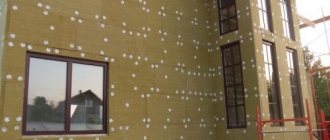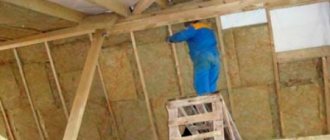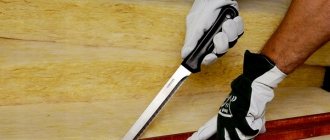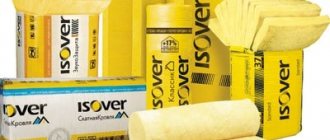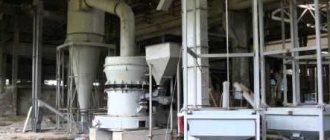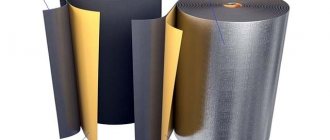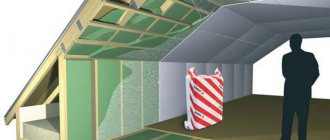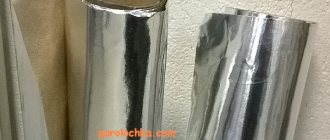Insulation materials
0 votes
+
Vote for!
—
Vote against!
Low heat loss, vapor permeability, light weight and non-flammability - these advantages of blown-in wool make it a popular thermal insulation material. Thanks to the automation of the installation process, the speed of insulation increases eight times compared to rolled materials. Learn the basic secrets of working with blown-in wool and get valuable advice from roof insulation specialists.
Table of contents:
- Pros and cons of blown wool - characteristics of the material
- Calculation of insulation thickness with your own hands
- Installation instructions for blown-in wool - technology and recommendations
- Do-it-yourself device for installing blow-in cotton wool
- Safety precautions for thermal insulation of a roof - methods of insulating a roof with ecowool
Pros and cons of blown wool - characteristics of the material
There are three options for blown wool in relation to its composition:
- basalt;
- glass wool;
- ecowool.
Mineral or basalt wool is made using basalt stones. The uniqueness of the composition ensures complete environmental safety of the material. Mineral blown wool does not contain formaldehyde and is not capable of forming glass dust, unlike glass wool.
Basalt and blown glass wool are made from scraps of thermal insulation boards. Cellulose wadding is based on recycled waste paper. Additional fire retardant and antiseptic compounds prevent rotting and burning of the material.
Let us note the following advantages of basalt-based blown wool:
1. Low level of thermal conductivity. Thanks to this, 4-5 times less heat is used to heat the house.
2. Light weight does not load the general structures of the building; blown-in wool is used both for insulation of walls and floors, and for thermal insulation of roofing floors.
3. The material has high vapor permeability and moisture-repellent properties. These indicators reduce the risk of developing fungus and mold in areas insulated with blown-in wool.
4. The fire safety of the building is ensured by absolute non-combustibility.
5. Basalt blown wool does not rot and has a long service life.
Another advantage of blown-in wool is its ease of installation. Thanks to the foamed consistency, the material gets into all the nooks and crannies. However, special compressor equipment is required to install the insulation. Automation of installation work can significantly increase the speed of laying insulation.
Blown-in cotton wool forms an integral seamless structure, inside which cold bridges do not form. The risk of additional heat losses is reduced. The insulation is installed both during the construction of the house and after the main finishing has been completed.
High-quality blow-in cotton wool has a uniform consistency, fills all voids, forming a continuous, even and dense layer. Using blown-in wool, pipes and building structures of various shapes and configurations are insulated.
Among the disadvantages of blown-in cotton wool, we note:
- the need to use special equipment to supply material under pressure;
- When installing blow-in wool on plasterboard structures, make sure that they are laid in two layers, otherwise they will swell;
- mineral and glass wool needs additional waterproofing;
- It is used most often for insulating structures with large volumes; it is inappropriate to order expensive equipment for insulating one wall of a house.
Calculation of insulation thickness with your own hands
When performing calculations to determine the thickness of the insulation, consider factors such as:
- the material from which the walls of the house are made;
- thermal resistance of the climatic region;
- number of windows and doors;
- additional heat losses;
- insulation composition;
- thermal transfer.
When insulating a house with cellulose-based blown-in wool, pay attention to the following indicators - an insulation thickness of fifteen centimeters is equal to:
- eighteen centimeters of mineral wool;
- forty-six centimeters of foam concrete;
- half-meter wooden beam;
- ninety centimeters of expanded clay;
- one and a half meters of brickwork.
Cellulose blown wool has an affordable price. The material resists the formation of fungus and mold. Environmental safety allows the use of blown-in cotton wool in any premises. The thickness of its installation depends on the density of the material used.
When calculating the thickness of the insulation, pay attention to the resistance of thermal transfer to the material. In order to determine the degree-day heating time, use the formula:
GSOP=(t8-t0t)ХЗot
- t8 - temperature in the house - its optimal value is from 18 to 22 degrees Celsius;
- he is the average air temperature;
- Zot - the number of days in which heating is used.
After determining this value, decide on the thickness of the insulation on the walls, ceiling, and floor. In addition, take into account the material from which the walls are constructed; for brick, concrete, wood and foam concrete, the indicators will be different.
For more accurate calculations, read the manufacturer’s recommendations on the number of layers for applying blown-in wool to various structures.
Installation instructions for blown-in wool - technology and recommendations
Ecowool is applied using a blow molding machine using a wet-glue or dry method. The first method is based on spraying an insulating layer: ecowool, adhesive solution, glue and a special dispersion. Next, the layer is cut to the required dimensions and dried. This method is called visual, since the specialist has the ability to control the filling of the frame with cotton wool. Installation work is carried out at temperatures above +5. Drying the products takes at least three days. Ventilation is required to prevent the accumulation of moisture and steam in the insulated space. As a result, the use of the wet-adhesive method makes it possible to obtain a coating with excellent heat and sound insulation characteristics.
A faster and easier to use method is the dry method of applying blown cotton wool. The inside of the frame structure is pre-coated with craft paper or construction cardboard. With their help, a closed space is created. To fix this material, use plastic mounting tape or a stapler. Next, the blown wool is fed into the frame using a special device. In this case, the adhesion of the material to the surface is less than when using the wet-glue method.
In general, we will highlight three main methods of applying blow-in cotton wool with your own hands:
1. Manual option - loosening the insulation with improvised tools and laying it on the surface. The quality of such insulation is low. Cotton wool is installed inside structures with maximum density. The method is relevant only for thermal insulation of small surfaces.
2. Blowing installations - used for preliminary loosening of ecowool. The device supplies the material under pressure, ensuring its uniform spraying on the surface. The advantage of the method is that it is seamless and there is no need to dismantle structures.
3. Blowing the surface using the wet method - the material is supplied simultaneously with water and glue. Thus, the quality of adhesion of the wool to the insulated surface improves. The surface is characterized by absolute evenness, rapid hardening of the material and good performance characteristics.
Blown-in cotton wool has a compressed shape and requires loosening with special equipment for application. The blow molding installation consists of the following components:
1. Base platform - has the shape of an island, the inside of which is filled with a gearbox, motor and air duct.
2. The basis of the mechanism is a low-precision type motor. It is characterized by low sound performance, minimal dust formation and long-term operation.
3. A device in the form of a gateway is used to capture the blown-in wool. The material fibers are pushed out using an inlet hose.
4. For the purpose of dosing cellulose material, the equipment is equipped with a valve.
5. To increase the supply speed of thermal insulation material, a gearbox is used.
6. In addition, the mechanism is equipped with a baking powder, a feeding hopper, a control panel and an emergency switch.
Do-it-yourself device for installing blow-in cotton wool
If you cannot rent or purchase expensive equipment for supplying blown-in cotton wool, we recommend using the option of replacing it with a homemade device. When working on the device you will need:
- a garden vacuum cleaner with a speed of at least 200 km/h;
- plastic container;
- corrugated hose, about 8 meters long, 60 cm in diameter;
- tape;
- electric drill with mixer attachment;
- cotton wool.
Instructions for assembling the blown wool feeder:
1. Disconnect one part of the vacuum cleaner and rearrange the terminals on it. This is necessary to enhance the power of the device.
2. Remove the teeth with the wire cutters provided with the dust bag. Otherwise, the blown-in wool will get into the device, causing it to jam.
3. Connect the corrugation to the dust collector of the vacuum cleaner. To fix it, use regular tape.
4. Using a cloth, make a seal that increases the tightness of the structure.
The device is ready - start using it. A minimum of two people will be required for the job. When insulating walls, make holes in their upper part with a diameter of about 6-7 cm. Fill a plastic container halfway with blown-in cotton wool. Ecowool is mixed with a construction mixer. The material will at least double in volume.
A corrugation is placed in a plastic container, not reaching the bottom by 30 cm. To seal the cracks, use a lining ring. Start the vacuum cleaner, which will pick up the cotton wool from the container, delivering it to the wall. The device is used exclusively for insulating ceilings or walls. Cotton wool will not be sprayed on the floor.
Safety precautions for thermal insulation of a roof - methods of insulating a roof with ecowool
The most important advantage of installing ecowool on roofing structures is the speed of completion of the work. Thermal insulation of a flat roof is completed in 3-4 hours. The structure of ecowool for insulation is loose and light. The material does not burn, does not form mold or mildew, and has high thermal efficiency.
After installation of ecowool, it fills all cavities and cracks without forming butt joints. Among the advantages of roof insulation with ecowool, we note:
1. Environmental safety and harmlessness of the material. Ecowool is used for both internal and external thermal insulation.
2. High thermal insulation abilities make this material convenient and effective to use.
3. The material does not rot, develop fungus or mold.
4. Ease of installation and speed of work is another advantage of blown-in cotton wool.
5. Compared to roll insulation, the cost of ecowool is an order of magnitude lower.
Working conditions and individual characteristics of the roof determine the method of using blown-in wool in everyday life. Polystyrene foam for thermal insulation of roofs is less effective compared to ecowool.
Dry installation is effective in the process of insulating the lower floor, attic, attic and horizontal sections of the roof. Insulation in a dry consistency is sprayed onto metal, concrete, wood, and brick surfaces. Roof insulation is completed in two hours by two people. This method is quite fast, but of lower quality than wet application of cotton wool. The wall is first covered with water diluted with glue, only after that the blown-in cotton wool is applied to the surface. The result is a perfectly smooth coating with higher performance characteristics.
The thickness of the application of blown-in wool on roofing areas should be at least 18 cm. Be sure to leave a ventilation gap of 10 cm. Make sure that snow does not accumulate on the thermal insulation material in winter, this will lead to its damage and a decrease in performance characteristics.
Apply blown-in cotton wool under the roof and on ceilings only using a dry method. It is necessary to stretch a vapor barrier membrane on the rafters and on the roof, which is fixed with boards. Ecowool is installed through small cuts in the membrane, and then they are sealed with tape.
Insulation of roof structures with blown-in cotton wool video:
Blowing basalt wool, Perm
Product description
Blown-in insulation (Blown-in wool) is a modern, environmentally friendly, safe for health, ensuring the absence of heat loss and sound absorption.
Blown-in cotton wool has recently been increasingly used to insulate walls, ceilings, floors and attics .
This type of insulation is low cost and does not burn, as it consists of mineral wool fibers. Blown-in wool is distinguished by low thermal conductivity, since when laid, mineral wool forms a continuous layer of insulation of uniform density without joints or abutments.
Unlike traditional sheet insulation, blown-in wool is literally blown in using special compressor-screw equipment directly into the desired location of the building structure. In this case, the insulation layer is formed directly on site as a single whole. Blown-in cotton wool tightly fills all voids and crevices, even in the most inaccessible places.
Blown-in wool envelops all pipes, beams, rafters and other irregularities on the surface of the building structure.
Blown-in wool can be used with equal success in buildings under construction and for restoring thermal insulation in old buildings, where it is blown over old thermal insulation material.
Blown-in wool is also of interest from a technological point of view, since insulation with its help is carried out very quickly. The productivity of the blown wool layerer is up to 400 m² per shift.
Since the equipment for forming a layer of blow-in wool is installed on the frame of a truck, the installation of thermal insulation from this insulation can be carried out directly from the wheels, from a distance of up to 200 m from the place where the layer of blow-in wool is formed horizontally and at a height of up to 100 m.

